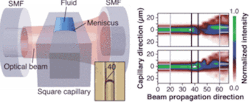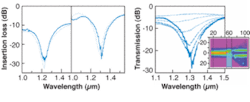Optofluidics enables compact tunable interferometer
CHRISTIAN GRILLET, PETER DOMACHUCK, BEN EGGLETON, and JUSTIN COOPER-WHITE
Interferometer-based modulators and optical switches are perhaps two of the most important photonic components for use in communications and sensing. The next generation of hybrid optical components must be compact and reconfigurable, allowing a higher degree of functionality and integration. For components operating in the micron-scale regime, generating the necessary phase delay to modulate the signal is a difficult task. Current types of modulation mechanisms—electro-optic and thermo-optic modulation—are unable to provide enough modification of the optical path at micron scales for generating the necessary range of tunability.
Optofluidics
An emerging technology that can achieve such results is optofluidics: the use of femtoliter volumes of fluid for optical modulation.1 Traditionally used in the biosciences for drug delivery or small-sample analyses, microfluidics has several attractive aspects in application to optics (see Laser Focus World, October 2004, p. 39). First, the refractive-index contrast between a fluid and the surrounding air can be quite large, providing much higher phase delays for interferometric devices in a more compact space than can be achieved by conventional modulators. Second, fluids are mobile, which allows for the infiltration of any void in a device and tunability through motion of the fluid body. As well as refractive-index modulation, fluids can incorporate a gain medium, be a liquid crystal, or be multiphase, all of which add to the functionality of the device.
At the Centre for Ultrahigh-bandwidth Devices for Optical Systems at the University of Sydney, in collaboration with the University of Queensland, we recently introduced a new class of highly compact tunable interferometric fluid-based devices that achieve phase differences by propagating a beam across a fluid/air discontinuity (meniscus). Using this principle, we have demonstrated a single-beam compact microfluidic Mach-Zehnder interferometer.2 It relies on the high contrast in refractive index across a fluid meniscus to achieve compactness. Tunability is provided through the mobility of the fluid phase, allowing the strength of the interferometric resonance to be adjusted.
We found that the performance of the device was influenced by the shape of the meniscus. We used a surface treatment to engineer the shape of the meniscus to optimize the device performance and found good agreement between the simulated and experimental response of the device, for which we observe a tunable resonance with an extinction ratio of 25 dB and an out-of-resonance loss of less than 3 dB, which is adjustable using meniscus position.
Basic concept and behavior
In the Mach-Zehnder interferometer, an input signal is split evenly into the device’s two arms, one of which induces a comparative delay resulting in a phase delay (see Fig. 1). When recombined, the phase shifting produces a change in the output intensity. An optical beam from a single-mode fiber (SMF) propagates across a fluid meniscus in a square capillary, after which it is collected by another SMF and is analyzed on an optical spectrum analyzer (OSA). Instead of splitting the beam into two spatially separated components (as is done in a conventional Mach-Zehnder), this device uses a single beam sectioned by a fluid meniscus. One part of the beam propagates in air and the other part propagates in fluid, which introduces a phase delay between the two sections of the beam. The beam then recombines with itself, creating a Mach-Zehnder-like response.
Because the fluid is a mobile phase, the position of the meniscus can be moved within the beam, sectioning the beam into different areas, which in turn modifies the transmission of light into a probe (output) SMF. The strongest resonance (lowest transmission) corresponds to the case in which the dividing interface is perfectly centered. As the dividing interface between the two media is displaced from the center, the resonance weakens.
This simple vision, well-depicted by a standard analytical approach, predicts the general behavior of such a device, but neglects such effects as beam divergence and meniscus shape—the latter proving to be a crucial parameter regarding the performance of this device.
Effect of the meniscus curvature
In the embodiment we use for our demonstration, a square silica capillary with core width of 10 µm and outer width of 80 µm is sandwiched between two SMFs. Deionized water is inserted into the capillary and the meniscus placed in the middle of the beam (see Fig. 2). The fluid plug is moved using a pressure differential created by a syringe pump.For untreated silica, the highly curved meniscus has a fluid-contact angle of approximately 40°. This strong curvature arises from the hydrophilic nature of the interaction between water and silica. Because the spatial extent of this meniscus is approximately the size of the beam, it has a large effect on the device performance. To explore the effect of meniscus curvature, we use the 3-D beam-propagation method to model various states of wetting, from contact angles of 40° (the untreated state of water on silica) to 90°. We find that the insertion (off-resonance) loss is minimized for a flat meniscus and increases rapidly for increasing curvature.
Experimental results
In view of the simulation results, we engineer the meniscus to be flat for optimum device performance using a process called silanization, which attaches organo-silane to the glass. This process is well suited for treatment of optical surfaces, as it forms a silica monomer on the surface of the glass that is extremely strong and only one molecule thick. This thinness ensures that the optical properties of the capillary remain unchanged. The nature of the organic part of the molecule governs the wetting angle of the fluid. In this case, we use dodeclytrischlorosilane, which implants a carbon C12 chain on the glass surface, resulting in a 90° contact angle with water. Transmission spectra of both the untreated and the optimized device can be compared to simulated spectra (see Fig. 3). Good agreement is seen between the predicted spectra and what is observed.Why fluid-based?
This device relies on the novel application of microfluidics to achieve the necessary optical interferometric path difference. Compared to planar-waveguide optical-delay lines or proposed photonic-crystal integrated Mach-Zehnder interferometers, the microfluidic Mach-Zehnder interferometer has a comparable extinction ratio (-25 dB for the microfluidic device, as compared to -30 and -22 dB, respectively, for the other two).
The microfluidic interferometer is far more compact than the waveguide delay line (which occupies square millimeters of area) and is comparable to the photonic crystal Mach-Zehnder (18 × 18 µm). The advantage of the microfluidic device is its degree of tunability (through surface treatments or through the modulation of the meniscus curvature via electrowetting), providing the basis for focusing optics or tunable attenuation. This device has optical performance comparable to state-of-the-art planar interferometers, with the advantage of multiple degrees of tunability that could be extended to every fluid-based interferometer.
Future developments
Because the meniscus position of this interferometer is dependent upon external pressure gradients, it may also have application as a pressure sensor. If we think in terms of integration, there is still a lot to be done before this new class of fluid-based devices becomes commonly used in integrated components. At the same time, much has already been done in terms of microfluidic handling. Combined with microfluidic valves, electrowetting techniques, dynamic refractive-index tuning through the use of liquid crystals, and a move to planar technology, this new class of device will not only serve optical telecommunications, but should also prove to be useful in applications like biosensing, medical diagnosis, and chemical analysis.
REFERENCES
1. P. Mach et al., Appl. Phys. Lett. 81, 202 (2002).
2. C. Grillet et al, Optics Express 12, 5440 (2004).
Christian Grillet is a research fellow, Peter Domachuck is a Ph.D. student, and Ben Eggelston is the director at the ARC Centre of Excellence for Ultrahigh-bandwidth Devices for Optical Systems (CUDOS), School of Physics, University of Sydney, Sydney, NSW 2006, Australia. Justin Cooper-White is associate professor of bioengineering in the Department of Chemical Engineering, University of Queensland, QLD, Brisbane 4072, Australia; e-mail: [email protected].


